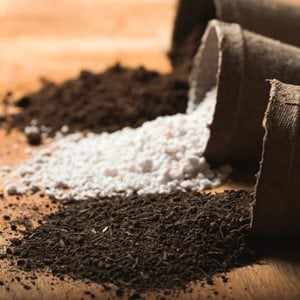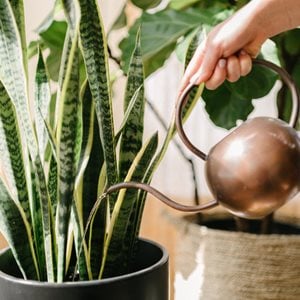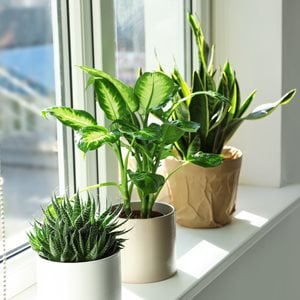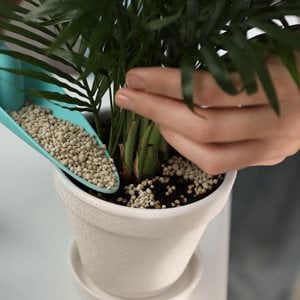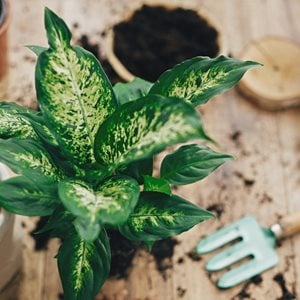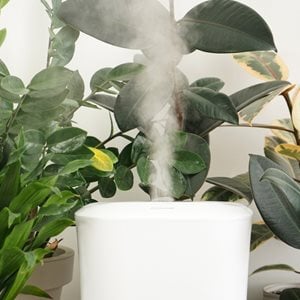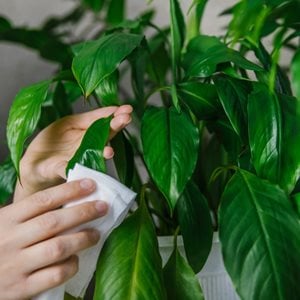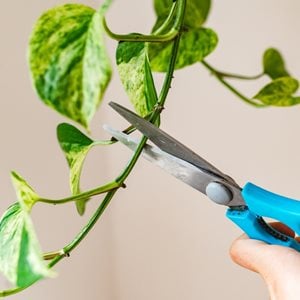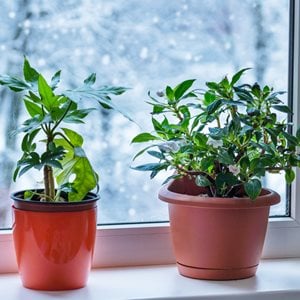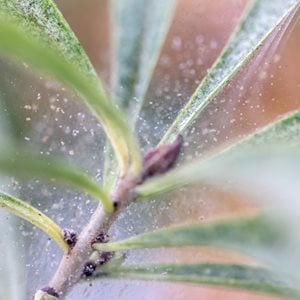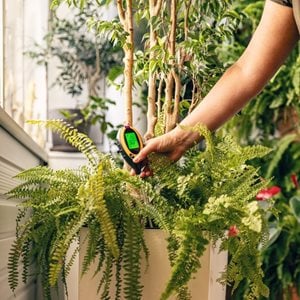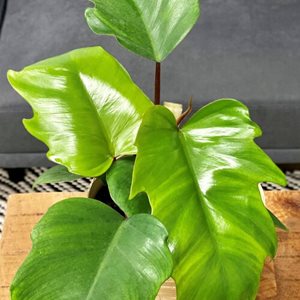Houseplant Care: 12 Tips for Healthy Indoor Plants
Whether you’re the proud parent of a new houseplant, or struggling to keep your existing plants alive, these indoor plant care tips are guaranteed to keep your houseplants happy and healthy.Have you ever wondered why even the most experienced outdoor gardeners are sometimes intimidated by growing houseplants? It may be due to one simple fact: Houseplants, unlike plants that grow outdoors, depend entirely on you for everything they need to live a long, healthy life.
Even though most indoor plants require only three basic components to survive—light, water, and a growing medium—knowing when to water, how much light to provide, and what type of soil to use can be tricky.
Beyond these basics, it’s also important to give your houseplants a comfortable environment, similar to what they’re used to in their native habitat. That might mean turning up the thermostat, boosting the humidity, and finding a location in your home free from drafts. Sure, it sounds complicated. But once you understand what your plants require, you will be able to grow almost any houseplant successfully.
1. START WITH GOOD SOIL
A healthy houseplant needs a strong root system, which depends on the right soil mixture. A high-quality potting mix promotes healthy roots by providing the perfect balance of good aeration and moisture-holding capacity. But that balance can differ from plant to plant.
Most houseplants will do fine growing in a standard indoor potting mix. However, cacti and succulents need a fast-draining mix to mimic the soil in their native environment while most tropical houseplants prefer a mix that retains moisture longer yet allows for good drainage and air flow. If you don’t want to buy multiple types of potting mix, you can amend an all-purpose mix with add-ins like perlite, sand, and orchid bark to accommodate each of your plant’s needs.
Learn more: Potting Soil 101
2. KNOW WHEN TO WATER
Proper watering is key to keeping your houseplants healthy, but knowing when and how much to water is often a matter of trial and error. Rather than counting the days between waterings, use your finger as a moisture meter and poke it into the top inch or two of potting mix. If the soil feels dry, it will be time to water most houseplants, with the exception of cacti and succulents, which can usually go longer between waterings. Also watch for visual clues that your plants need water, like leaves that are beginning to wilt or droop.
When you do water your plants, soak the plant thoroughly so the soil is evenly moist, and allow the excess to flow out of the drainage holes in the pot to prevent root rot. It’s always better to water your houseplants less often and more deeply than to give them light, frequent waterings.
TIPS: Always use room-temperature water; anything too warm or cold can shock your plant and damage the roots. And, if your tap water is highly chlorinated, it's best to let your water sit out for at least 24 hours to allow the chlorine to dissipate.
3. PROVIDE ENOUGH LIGHT
When you buy a new houseplant, it will usually come with a tag telling you the optimum amount of light to give it, ranging from low (think north-facing window) to bright indirect light (east- or west-facing window, but away from direct sun) to bright direct light (the more sun, the better).
Most houseplants thrive in moderate to bright light, as long as there is no risk of scorched foliage or overheating. If you have a space with little natural light, invest in LED grow lights or choose houseplants that can tolerate low light. Do not try to grow houseplants that require high levels of light (such as most cacti and succulents) in a dim, poorly lit room because they will struggle to survive.
How can you tell if a houseplant is getting the level of light it needs? If the foliage starts to lose color or develop brown, dry edges, those are usually signs that your plant is receiving too much light. If your plant stops putting out new growth, becomes leggy, or begins to stretch toward the light, try moving it to a sunnier location or closer to a window.
TIP: Leaves will naturally turn toward the light, so rotate your plants regularly to ensure even growth.
4.FERTILIZE, BUT NOT TOO OFTEN
Every time you water your houseplants, nutrients are leached out of the soil. Fertilizing your plants regularly will replace these nutrients, but the frequency of fertilization can vary depending on the time of year and the plant’s growth rate. A good rule of thumb is to feed your plants in spring and summer, when they are actively growing, and then hold off on fertilizing during the late fall and winter months, when most houseplants are semi-dormant.
Fertilizers are available in many forms, including liquids, water-soluble pellets, and time-release spikes that you insert into the soil. Generally, any brand labeled for use on indoor plants will do the job, but always refer to the directions on the package for recommended application rates.
Keep in mind that overfertilizing, like overwatering, can be detrimental to houseplant health. That’s because excess salt in fertilizers build up in the soil over time and can burn the roots and limit moisture uptake. If you do accidentally overfertilize a plant, give it a thorough watering to flush out these harmful salts or repot it in fresh soil.
5. REPOT IN SPRING
Most houseplants eventually outgrow their original containers and will need repotting in fresh soil to stay healthy and to continue growing vigorously. How do you know it’s time to move your plant to a new home? Two telltale signs are long strands of roots poking out of the pot’s drainage holes and water that runs right through pot without saturating the soil.
The best seasons for repotting houseplants are spring and summer because the roots are actively growing and will appreciate the additional space. When choosing a new pot, it should be no more than two inches larger in diameter than the old one. Transplanting into too large of a pot results in the soil staying too wet, increasing the chance of root rot.
TIP: When transferring a pot-bound plant into a new container, you may notice that the roots have circled around the inside of the pot. To help these roots penetrate the new potting mix, make 1/2-inch-deep cuts from the top of the rootball to the bottom on all sides with a sharp knife. This won’t hurt the plant and will actually help stimulate new root growth.
6. BOOST THE HUMIDITY
Many tropical houseplants, like pothos, philodendron, and arrowhead vine, prefer humidity levels above 40%, which is hard to maintain in most rooms of the home, with the exception of a steamy bathroom. To raise the humidity around your plants, run a humidifier, mist the leaves occasionally, or set their pots on a shallow tray or saucer filled with pebbles and water (making sure the bottom of the pot is not sitting in the water).
Also keep your houseplants away from sources of dry air, like heater vents and drafty doorways and windows.
See more plants that thrive in high humidity.
7. KEEP THE LEAVES CLEAN
Allowing dust to accumulate on the leaves of your houseplants inhibits their ability to photosynthesize and can clog the tiny pores they use to breathe. To keep the foliage dust-free, occasionally wipe the leaves with a damp cloth or sponge or give your plants a gentle room-temperature shower. For plants with fuzzy leaves, like African violets, gently brush off the dirt with a small soft-bristled paintbrush.
Cleaning your houseplants regularly offers another benefit: It helps to get rid of spider mites and other insect pests that might be feasting on the leaves.
8. PRUNE AS NEEDED
Pruning or pinching a houseplant is sometimes necessary to improve the shape, keep it more compact, or to remove spent blooms and yellowing or diseased foliage. Cutting back overgrown houseplants can also help rejuvenate them and encourage fuller growth. Although not all houseplants require pruning, most will benefit from at least a little reshaping.
When making your pruning cuts, use a sharp pair of small hand pruners and snip just above a leaf node to avoid unattractive bare stems. Also make the cuts at a 45-degree angle to prevent moisture from collecting on the cut. With most houseplants, you can use the cuttings to propagate new plants and expand your houseplant collection for free. *See notes below on propagating patented plants (check your plant tags for ® or ™ symbols next to the plant name).
How much can you prune without harming your houseplants? The one-third rule is a good one to follow for most houseplants. Pruning off more than a third of the plant at one time can send it into shock.
9. MOVE PLANTS WITH THE SEASONS
To compensate for the lower angle of the sun and fewer hours of daylight during the late fall and winter months, you may need to move your houseplants around to give them as much sun exposure as possible, especially plants that crave very bright light, like succulents and cacti. Even moving your plants under a grow light for a few hours a day can help compensate for the loss of light. Although some houseplants resent being moved around, like fiddle-leaf fig, most are resilient enough to handle frequent moving.
Get more tips for keeping your houseplants healthy in winter.
10. WATCH FOR COMMON PESTS
Frequently inspecting your houseplants for pests is important so you can treat an infestation before it gets out of hand. If you do find pests on one or more of your houseplants, the sooner you act the better. Some pests, like spider mites, can do a lot of damage quickly and will spread readily from plant to plant. The first step is to isolate infested plants to prevent the problem from spreading. Once you treat the affected plants, don’t take them out of isolation until you’re sure the pests are gone for good.
TIP: Houseplant pests often get into your home by hitching a ride on a new houseplant. Whenever you buy a new plant, place it in quarantine for a few days and inspect it for pests before you mix it in with your other plants. The same holds true for houseplants that you bring indoors after allowing them to enjoy a summer vacation outside.
Learn more about identifying and treating the most common houseplant pests.
11. EMBRACE TECHNOLOGY
If you want more accurate readings of soil conditions and light levels for your houseplants, consider investing in a 4-in-1 plant meter that can detect soil moisture, nutrient levels, how much sunlight your plant is getting, and even the pH value of the soil. These devices take much of the guesswork out of houseplant care and can be especially helpful for people who are new to indoor gardening and lack first-hand experience. Even a basic soil moisture meter is good to have on hand because it can help prevent you from overwatering, the most common cause of poor houseplant health.
12. CHOOSE YOUR HOUSEPLANTS WISELY
Today, you have a wider choice of houseplants than ever before, from familiar favorites to a countless array of new hybrids. Whatever your tastes, be sure to choose plants not only for their aesthetic appeal but also with an eye to where you will place them and how much care they will require. Selecting a houseplant with light and humidity requirements that match the location is key. And if you have little time to fuss over your plants, look for varieties that are tough enough to survive just about anywhere with minimal care (see 24 Best Indoor Plants for Any Location.)
TIP: Always buy your houseplants from a reputable garden center or nursery. And if you prefer to buy your plants online, look for a vendor that guarantees their plants and will replace them if they arrived damaged or unhealthy.
We recommend plants in the leafjoy® Collection from Proven Winners.
*REGARDING PROPAGATION: When it comes to propagating patented plants, there are strict rules in place prohibiting reproduction or propagation of these plants in any way. This means you can't reproduce them (even for use in your own garden), sell them, or bring them into the country without permission. The law does not make exceptions for what some might consider minor infringements. Any unauthorized use of patented plants is considered an infringement.
